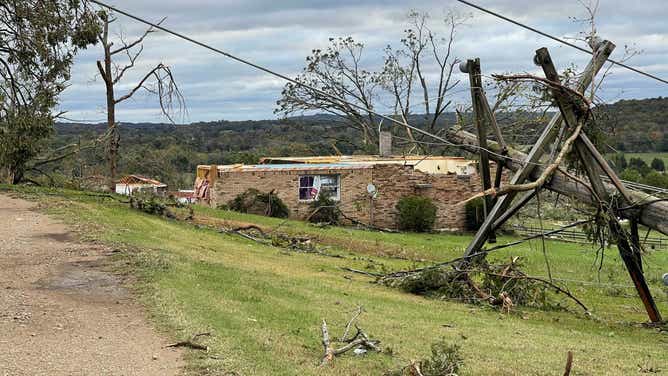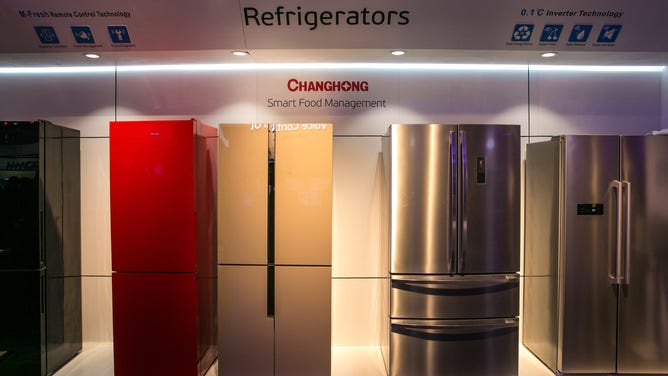What happens to expensive electronics when the power goes down, are they safe?
California Storms knock power out to over 167,000 customers this past weekend. Surge protectors may not be enough!
Sunday's flooding rains in California knocked power out to more than 167,000 people. Severe thunderstorms and tornadoes left 3,800 Missouri and Illinois residents and businesses in the dark just this past weekend.
Power outages happen all the time. Blame it on severe storms, brownouts, hurricanes, even a car accident knocking down a power pole.
We have all been working on a computer or watching TV when the light flickers then darkness. The power goes out and takes our computers, televisions, and household appliances with it.
A line of tornadoes destroyed homes and buildings near Farmington, Missouri.
(Nicole Valdes / FOX Weather)
Ideally, we would turn all electrical equipment off before the power goes down. But, so many times, we have no idea there is going to be trouble.
Pat Pearson of Pearson Appliances in Napa says nothing is safe.
"Sub-Zero refrigerators and freezers, microwaves, stereos … Everything has computer chips that can be damaged. Depending on where you are in the (power) the line, you can get a surge when the power comes back on initially," Pearson says.
Some higher-end power supplies actually delay delivering current to your computer, allowing the power levels to level out before hitting your computer. But, Chron warns, aftermarket power supplies do not have the extra protection.
The Pacific Gas and Electric Company, PGE, says it is normal for electric voltage to vary within limits, "Momentary interruptions are more common and can happen six to 12 times a year. Most utility companies such as PG&E have devices to keep these interruptions temporary, clearing them within a few seconds. The most noticeable result of a momentary interruption is a blinking digital clock."
Is a surge protector enough?
Most people use surge protectors which absorb higher-voltage current. Take a look at your power strips, not all of them are surge protectors, even though they look alike.
Surge protectors have a maximum limit of energy which they can absorb, just the way a wet sponge can't pick up more water or glass can't hold any more juice. Sometimes a light on the protector goes on to alert you the energy sponge is full, but it is better to be safe than sorry. White Electric says to replace your surge protector every two years. You might want to do it sooner if you have a lot of construction in the area, have suffered several power outages or had nearby lightning strikes. Costs are generally $10-50.
You can also ask your electrician to install a surge protector at your main electrical panel. The equipment will run you in the low hundreds, but installation could run over $1,000.
Some insurance companies will not insure electronics losses unless a surge protector protects them.
Pricey computers in a home office.
(Photo by Romy Arroyo Fernandez/NurPhoto via Getty Images / Getty Images)
Want more protection?
The next level of protection is an uninterruptible power supply, also known as a UPS. A UPS looks like a surge protector but has built-in battery backup, usually 5 to 15 minutes depending on the brand. This allows you to shut computers down and turn off TVs. This protection is excellent for short interruptions, but you have to be home to take advantage of the UPS during more extended outages. Also, while every plug-in is connected to the surge protector, only specific receptacles have the battery backup. Batteries will lose charge over time, so plan on replacing a UPS every two years. These will run you in the hundreds of dollars range.
Do you want even more protection or maybe the sags bother you?
"They can last milliseconds and create a drain on your power. You may notice these drains when the lights dim as the refrigerator starts, but usually, you won't notice them. Large loads (refrigerator, washer or dryer) turning on or off can trigger swells and sags," PGE says.
A power conditioner smooths out power variations that flow through the line. They look like a UPS and have surge protection, but they also filter out noise and short-term variations, like when your refrigerator turns on.
Best practices to save your electronics and appliances
When your power goes out, unplug everything but a light. This way you can avoid the initial surge when the power returns. You can also avoid power sag that happens as all of your refrigerators, blow dryers, clothes dryers come on all at once (the power dips to then comes back again).
High-tech home refrigerators run by computer chips are dependent on a steady supply of electricity.
(George Rose/Getty Images / Getty Images)
Pearson says the most expensive problem he sees in Napa is a power outage to a refrigerator or a freezer.
"Just in the Glass Fire (2020), PG&E cut the power (in a Public Safety Power Shutoff) then those folks got evacuated. The food in the Sub-Zeros goes bad and rots. The smell is putrid, and it gets into the liner and insulation," Pearson says.
He sold half a dozen $10-$20,000 fridges in a week. He even explained to their insurance companies there was no way to salvage the old units.
The bottom line is:
- Try to turn off all your equipment when the power goes down then slowly power it back up when the current has stabilized in the wires.
- Use at least a surge protector and replace it every two years.
- Don't leave food in your fridge for too long.



